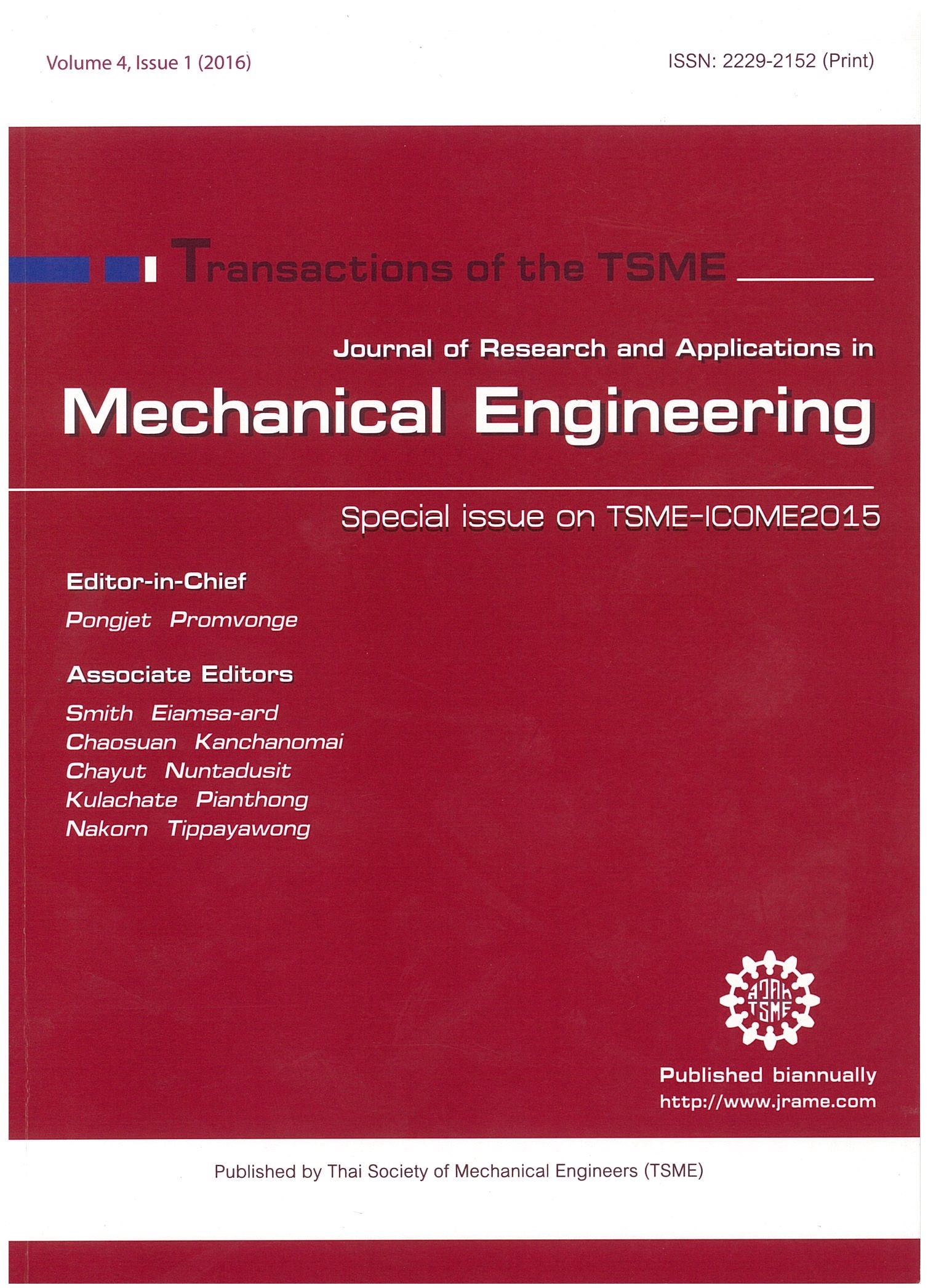Non-linear finite element analysis of time-varying thickness and temperature during the extrusion blow molding process
Main Article Content
Abstract
This paper presented the use of non-linear finite element analysis (FEA) software to simulate the extrusion blow molding process. We used MSC.MARC to evaluate the thickness and temperature variation in time during the process. The investigation was done on an axis-symmetric bottle made from high density polyethylene (HDPE). The mathematical model for HDPE used visco-elastic material. Our simulation combined both the mold closing and pressure blowing processes in one event. The FEA result compared with the measured thickness, from the processed bottles was observed. In the thickness analysis, we defined the thickness ratio (TR) of the parison and bottle; and found that, the TR was uniform for the analysis range of the initial parison thickness between 2.4 ± 0.2 mm. When the change of the parison thickness is frequently requested during the design and manufacturing processes, the constant TR can be applied; hence, reduces the analysis time. When the hardening temperature of HDPE is
known, the time variation plots of the temperature and thickness are useful for predicting the process times.
Article Details
This work is licensed under a Creative Commons Attribution-NonCommercial-ShareAlike 4.0 International License.
References
[2] Lee, N.C. Plastic Blow Molding Handbook, Van Nostrand Reinhold, 1990.
[3] Liu, S.J. Computer simulation of the inflation process in blow molding, Journal of Reinforced Plastics and Composites, Vol. 18(8), 1999, pp. 759-774.
[4] Fukuzawa, Y., Tanoue, S., Iemoto, Y., Kawachi, R. and Tomiyama, H. Three-dimensional simulation on multilayer parison shape at pinch-off stage in extrusion blow molding, Polymer Engineering & Science, Vol. 50(7), 2010, pp. 1476-1484.
[5] Gupta, S., Uday, V., Raghuwanshi, A.S., Chowkshey, S., Das, S.N. and Suresh, S. Simulation of blow molding using ANSYS Polyflow, APCBEE Procedia, Vol. 5, 2013, pp. 468-473.
[6] Huang, H., Li, J., Li., D. and Huang, G. New strategies for predicting parison dimensions in extrusion blow molding, Poly-Plastics Technology and Engineering, Vol. 50(13), 2011, pp. 1329-1337.
[7] Cosson, B., Chevalier, L. and Regnier, G. Simulation of the stretch blow moulding process: from the modelling of the microstructure evolution to the end-use elastic properties of polyethylene terephthalate bottles, International Journal of Material Forming, Vol. 5, 2012, pp. 39-53.
[8] Zimmer, J. and Stommel, M. Method for the evaluation of stretch blow molding simulations with free blow trials, IOP Conference Series: Materials Science and Engineering, Vol. 48, 2013, Article ID 012004.
[9] Bougharriou, A., Jeridi, M., Hdiji, M., Boughrira, A. and Sai, S. Finite element analysis of PMMA stretch blow molding, International Journal of Manufacturing Engineering, 2014, Article ID 175743.
[10] Mase, G.T., Smelser, R.E. and Mase, G.E. Continuum Mechanics for Engineers, 3rd edition, CRC Press, 2010.
[11] Rugsaj, R., Thusneyapan, S. and Suvanjumrat, C. Finite element models for analysis the parison thickness of extrusion blow molding process, 6th TSME International Conference on Mechanical Engineering, Petchburi, Thailand, 2015, Article ID CST5.
[12] Shames, I.H. and Cozzareli, F.A. Elastic and Inelastic Stress Analysis, Prentice-Hall, 1992.
[13] Ferry, J.D. Viscoelastic Properties of Polymers, 3rd edition, John Wiley & Sons, 1980.
[14] Rugsaj, R. Parison Thickness Analysis for Extrusion Blow Molding, ME thesis, Kasetsart University, Bangkok, Thailand, 2014.
[15] Laroche, D., Kabanemi, K.K., Pecora L. and Diraddo, R.W. Integrated numerical modeling of the blow molding process, Polymer Engineering & Science, Vol. 39(7), 1999, pp. 1223-1233.



